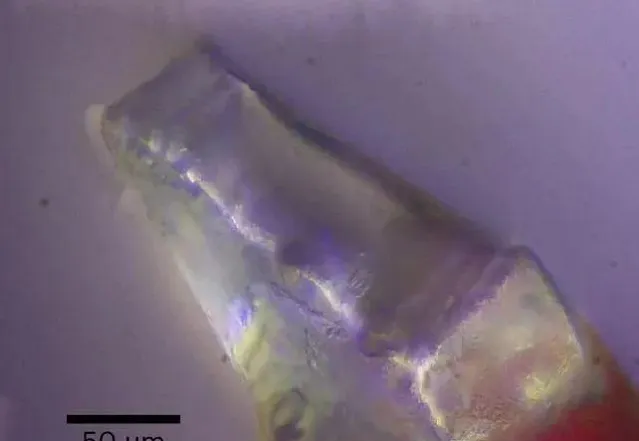
来源丨Sciencealert Space
作者丨 Michelle Starr
翻译丨百度翻译AI大模型
月球上有水,科学家们刚刚确认了大量水可能藏匿的地点。
There's water on the Moon, and scientists have just confirmed where a lot of it may be hiding.
中国嫦娥五号着陆器收集并运送至地球的月球尘埃中的一种矿物质最近被发现含有大量的水,占其重量的41%。
A mineral in Moon dust collected by China's Chang'e-5 lander and ferried to Earth was recently found to contain so much water, it makes up 41 percent of its weight.
这种矿物与几年前在俄罗斯堪察加半岛的玄武岩中发现的novograblenovite相似。月球和地球上的这两种矿物都具有化学式(Np)MgCl3·6pO,并且具有相似的晶体结构。
The mineral is similar to novograblenovite, which was only identified a few years ago in basaltic rock from Russia's Kamchatka Peninsula. Both the lunar and terrestrial versions have the chemical formula (Np)MgCl3·6pO, and have similar crystalline structures.
鉴于我们可以在地球上研究新矿物,在月球上发现一种几乎相同的矿物可以为我们提供一些线索,告诉我们月球水藏在哪里,它是如何到达那里的,以及月球水的历史。
Given that we can study novograblenovite right here on Earth, the discovery of an almost identical mineral on the Moon can give us some clues about where lunar water is hiding and how it got there – as well as the history of lunar pO.
月球上水的来源、存在和分布仍然是个谜。这是科学家们想要弄清楚的问题,因为月球上的水分来自哪里,现在又在哪里,是地球-月球系统历史的重要组成部分。
The origin, presence, and distribution of water on the Moon remain something of a mystery. It's something scientists want to figure out, because where the Moon's moisture came from and where it is now is an important component of the history of the Earth-Moon system.
此外,知道水藏在哪里对未来的月球探索任务具有重要意义,因为人类生存需要水。
In addition, knowing where water is lurking has significance for future lunar exploration missions, since humans need water for survival.
之前在较老的月球样本中也发现了水,这些水被困在微小的玻璃珠中,这些玻璃珠是在月球表面物质融化并形成所谓的球体时产生的。在月球表面反射的光谱中检测到水信号表明,月球上还有更多的水。
Water has been found in older lunar samples before, trapped in tiny glass beads that are produced when surface material melts and forms what are known as spherules. Detections of water signals in the spectrum of light reflected from the Moon's surface suggest there's plenty more up there, somewhere.
一个普遍的观点是,水存在于构成月球风化层的矿物质中。然而,此前的研究表明,月球土壤中存在的氢和氧可能以其他羟基分子的形式存在——这些化合物的氢和氧的比例与水的比例不同。
One prevailing notion is that water is bound up in minerals that comprise the lunar regolith. Previous studies, however, have suggested that the hydrogen and oxygen bound up in Moon dirt could be in the form of other hydroxyl molecules – compounds made up of hydrogen and oxygen in proportions different from that of water.
然而,当嫦娥五号于2020年12月降落在月球上时,它取得了一项突破——首次在月球上的一块巨石中就地探测到疑似水。然而,目前尚不清楚探测到的究竟是分子水还是另一种羟基分子。这需要比机器人着陆器所能提供的更仔细的分析。
When it landed on the Moon in December 2020, though, Chang'e-5 made a breakthrough – the first in situ detection of what appeared to be water in a boulder on the Moon. It was unclear, though, whether the detection was actually molecular water, or another hydroxyl molecule. That required a closer analysis than what a robotic lander could provide.
现在,中国科学院物理学家金世峰和郝木楠带领的地球人类已经进行了这项分析,他们将嫦娥五号任务送回地球的样本进行了X射线晶体衍射和化学同位素分析技术,以确定月球风化层是否含有水或其他物质。
Now, humans on Earth led by physicists Shifeng Jin and Munan Hao of the Chinese Academy of Sciences have performed that analysis, subjecting samples sent to Earth by the Chang'e-5 mission to X-ray crystal diffraction and chemical isotope analysis techniques to determine whether the lunar regolith contains water or something else.

发现含有水的微小矿物颗粒
他们的努力揭示了分子水的存在,其中矿物(Np)MgCl3·6pO含有多达六个水分子晶体。
Their efforts revealed the presence of molecular water, with the mineral (Np)MgCl3·6pO containing up to six water crystals.
Novograblenovite在地球上很少形成,它是由热玄武岩与富含水和氨的火山气体相互作用而产生的。月球矿物不太相同——其中发现的氯同位素与陆地氯同位素的组成不同——但其形成机制可能非常相似。
Novograblenovite rarely forms on Earth, emerging from the interaction of hot basalt with volcanic gasses that are rich in water and ammonia. The lunar mineral isn't quite the same – the chlorine isotope found within it has a different composition to terrestrial chlorine isotopes – but its formation mechanism is likely to be quite similar.
这表明,当月球过去火山活动活跃时,月球上存在水和氨的来源。
This suggests a lunar source of both water and ammonia existed when volcanic activity was active in the Moon's past.
中国科学院在一份声明中写道:「热力学分析表明,当时月球火山气体中水含量的下限与地球上最干燥的火山——伦盖伊火山的下限相当。」
"Thermodynamic analysis shows that the lower limit of the water content in the lunar volcanic gas at that time was comparable to that of the driest volcano on Earth today, Lengai Volcano," the Chinese Academy of Sciences writes in a statement.
「这揭示了月球火山脱气的复杂历史,对探索月球的演化具有重要意义。」
"This reveals a complex history of lunar volcanic degassing, which is of great significance for exploring the evolution of the Moon."
这一发现还表明月球上存在一种以前未知的水源——水合盐。这比水冰稳定得多,表明它甚至可能在经常沐浴在阳光下的月球区域存在,从而减少我们未来对月球两极阴影陨石坑深处封存的水冰的依赖。
The discovery also suggests a previously unknown source of water on the Moon – hydrated salts. This is much more stable than water ice, suggesting that it may be available even on areas of the Moon frequently bathed in sunlight, reducing our future possible reliance on water ice sequestered deep in shadowed craters at the lunar poles.
该团队的发现已在【自然天文学】上发表。
The team's findings have been published in Nature Astronomy.
内容来源于百度人才智库【今日信息差】栏目精选推荐
百度翻译,200种语言互译,4万多个翻译方向,内含新闻资讯等9大行业领域翻译。AI大模型翻译还支持知识库上传及专业术语定制,翻译后可进行译文编辑、双语审校、联网查证、译文答疑、母语润色、语法分析,满足各行业专业人士的全方位需求。
欢迎访问PC端 🔍 https://fanyi.baidu.com 体验更多产品功能











